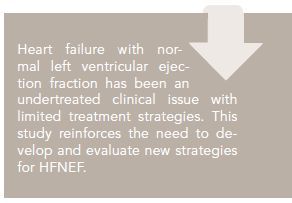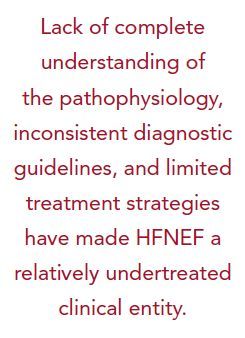Publication
Article
Cardiology Review® Online
Trends in Patients Hospitalized With Heart Failure and Preserved Left Ventricular Ejection Fraction: Prevalence, Therapies, and Outcomes

Sucheta Gosavi, MD
Review
Steinberg BA, Zhao X, Heidenreich PA, et al; for the Get With the Guidelines Scientific Advisory Committee and Investigators. Trends in patients hospitalized with heart failure and preserved left ventricular ejection fraction—prevalence, therapies, and outcomes. Circulation. published online May 21, 2012. http://circ.ahajournals.org/content/early/2012/05/21/CIRCULATIONAHA. 111.080770

Heart failure (HF) with normal left ventricular ejection fraction, also known as HFNEF, is characterized by clinical signs and symptoms that are similar to those occuring with HF with reduced left ventricular systolic function. Lack of complete understanding of the pathophysiology, inconsistent diagnostic guidelines, and limited treatment strategies have made HFNEF a relatively undertreated clinical entity. In this study, Steinberg et al evaluated patients who were hospitalized for HF with normal, borderline, and reduced left ventricular systolic ejection fraction, and have discussed the outcomes, rates of hospital admissions, and the management during hospitalization and at discharge of these patients.
Study Design
A total of 110,621 study participants were analyzed from 275 hospitals. All were enrolled in the Get With the Guidelines Heart Failure (GWTG-HF) study from January 2005 to October 2010 and had a clinical diagnosis of HF. The 16,631 patients who were excluded were also compared with the 110,621 patients studied. All patients studied had left ventricular ejection fraction (LVEF) measured either during the hospitalization or prior to that. The patient population was divided into 3 groups consisting of normal LVEF >50%, borderline LVEF <50%, and reduced LVEF <40%, depending on the LVEF. All core quality measures for the diagnosis of HF were assessed in all 3 groups during hospitalization and at discharge.

The study analyzed and compared the 3 groups based on the LVEF for demographics consisting of age, gender and race, and medical history, which included history of atrial fibrillation (AF) and/or flutter, chronic obstructive pulmonary disease (COPD), asthma, diabetes mellitus (DM), hyperlipidemia (HL), hypertension (HTN), peripheral vascular disease (PVD), prior mycocardial infarctions (MI), prior HF, cerebrovascular accidents (CVA) including stroke and transient ischemic attack, anemia, chronic renal failure (CRF), and smoking. Blood pressure control, anticoagulation for AF, hospital events and procedures including right and left catheterization, smoking cessation, lipid-lowering therapy (especially for patients with diabetes and atherosclerosis), administration of angiotension receptor blockers (ARBs), angiotension converting enzyme inhibitors (ACEIs), and ß-blockers, and different dispositions (home, skilled nursing facility [SNF], inpatient rehabilitation, hospice, or another acute care facility) were all compared at the time of discharge in the 3 groups. The study included patients from all over the United States.
Among all 110,621 patients admitted with HF over the study period, 36% had preserved LVEF (>50%), 50% had reduced LVEF (<40%), and 14% had borderline LVEF (between 40%-50%). Patients with preserved LVEF were older, more often female, had a history of hypertension, AF, and chronic renal failure, a higher body mass index (BMI), higher systolic blood pressure, and lower brain natriuretic peptide (BNP) and N-terminal pro-BNP and troponin values compared with patients with reduced and borderline LVEF.

It was noted that 84% of the patients hospitalized with HF with preserved LVEF had no procedures performed during hospitalization, compared with 69% of patients with low LVEF and 80% with borderline LVEF. Dialysis or ultrafiltration was the only procedure that was noted to be more common in patients with preserved LVEF (4.8%), as many of these patients had multiple comorbidities including DM and HTN. The rate of dialysis or ultrafiltration was 4.6% for borderline LVEF and 3.1% for patients with reduced LVEF. The patients with preserved LVEF had fewer right- and left-heart catheterizations compared with the other 2 groups.
Fewer patients with HFNEF were administered ARBs/ACEIs, aldosterone antagonists, blood pressurelowering therapy, and lipid-lowering therapy during hospitalization and at the time of discharge compared with those with reduced LVEF. Patients with HFNEF had higher systolic blood pressure at discharge and more discharges to SNFs and/or inpatient rehabilitation, possibly due to less strict application of HF core measures and/or more comorbidities. The length of stay for these patients was
greater than 4 days; their in-hospital mortality was more than for those with borderline LVEF but less than for those with LVEF <40%.
Temporal analyses showed that during the study period from 2005 to 2010 there was an increase in the inpatient admission rate from 33% to 39% for patients with preserved LVEF, a constant rate of 10% for those with borderline LVEF, and decreased rate for those with reduced LVEF. ß-blocker use was increased in all 3 groups. ACE/ARB and aldosterone antagonist use was decreased at discharge for all 3 groups, most commonly due to worsening renal function.
Among the hospitals that participated in the GWTG-HF program, the average hospital size was 420 beds, with 52% of patients admitted to hospitals employing residents; 58% were academic centers (6% of academic centers had no residents), and 69% were admitted to hospitals capable of performing percutaneous interventions. Seventy-two percent of the hospitals had the capability to perform cardiac surgeries, and 10% were cardiac transplant centers.
References
1. Fonarow GC, Stough WG, Abraham WT, et al. Characteristics, treatments, and outcomes of patients with preserved systolic function hospitalized for heart failure. a report from the OPTIMIZE-HF Registry. J Am Coll Cardiol. 2007;50:768-777.
2. Yancy CW, Lopatin M, Stevenson LW, et al. Clinical presentation, management, and in-hospital outcomes of patients admitted with acute decompensated heart failure with preserved systolic function. a report from the Acute Decompensated Heart Failure National Registry (ADHERE) Database. J Am Coll Cardiol. 2007;47:76-84.
3. Paulus WJ, van Ballegoig JJM. Treatment of heart failure with normal ejection fraction: an inconvenient truth! JACC. 2010;55:526-537.
4. Granger CB, McMurray JJ, Yusuf S, et al for the CHARM Investigators and Committees. Effects of candesartan in patients with chronic heart failure and reduced left-ventricular systolic function intolerant to angiotensinconverting-enzyme inhibitors. The CHARM Alternative trial. Lancet. 2003;362:772-776.
5. Massie BM, Carson PE, McMurray JJ, et al. Irbesartan in patients with heart failure and preserved ejection fraction. N Engl J Med. 2008;359:2456-2467.
6. Paulus WJ, Tschöpe C, Sanderson JE, et al. How to diagnose diastolic heart failure: a consensus statement on the diagnosis of heart failure with normal left ventricular
ejection fraction by the Heart Failure and Echocardiography Association of the European Society of Cardiology. Eur Heart J. 2007:28;2539-2550.
7. Redfield MM, Jacobsen SJ, Burnett JC Jr, et al. Burden of systolic and diastolic ventricular dysfunction in the community: appreciating the scope of heart failure epidemic. JAMA. 2003;289:194-202.
8. de Bie MK, Ajmone Marsan N, Gaasbeek A, et al: Left ventricular diastolic dysfunction in dialysis patients assessed by novel speckle tracking strain rate analysis: prevalence and determinants [published online ahead of print May 9, 2012]. Int J Nephrol. 2012;2012:963504.
COMMENTARY
Increasing Recognition of Heart Failure With Normal LVEF
The study by Steinberg and colleagues has reiterated the need for development and evaluation of new treatment strategies for patients with HFNEF. In the last few years, HFNEF has achieved more recognition in clinical practice. Like the OPTIMIZE HF1 and ADHERE2 registries, this study shows an increasing proportions of patients with HFNEF over the years. The study has been conducted in several different hospitals under different settings—academic, semiacademic, and private settings over a fairly long period time of time. However, it is an observational study from a select population consisting of only those who were enrolled in the GWTG-HF study. In addition,
invasive or noninvasive measurement of diastolic dysfunction was not performed in all patients. The estimation of LVEF has a high extent of interobserver variability.
The findings of this study are similar to those of prior registries and studies.1,3 Although this study has shown an increase in the incidence of HFNEF patients, overall in-hospital mortality appears to have decreased. The patient population and the risk factors noted in prior studies are also similar, but inadequate control of both systolic and diastolic hypertension specifically at discharge was noted in this study. Discharge instructions for HF were also not given stringently for patients with HFNEF as they were for HF patients with systolic dysfunction.

Review of the literature shows inadequate and improper care for patients with HFNEF. This is partly limited by lack of targeted pharmacological agents. Most common medications that have been beneficial in patients with systolic dysfunction have not shown any significant benefit in patients with HFNEF. The CHARM-Alternative trial4 showed some benefit with candesartan, but irbesartan from the same class of medication failed to show any improvement.5 The contradictory outcomes could be due to an intrinsic difference in the pathophysiology of LV remodeling in the 2 types of HF.6
Extensive research is still needed to understand the pathophysiology of diastolic HF. In addition, incorrect identification of HFNEF patients has also been a cause for unsatisfactory results from trials.3 Patients with HFNEF should have an accurate LVEF estimation with multiple quantitative EF estimations by multiple observers, left ventricular end diastolic dimension, and a well-defined diastolic dysfunction diagnosis with grades of diastolic dysfunction. Redfield et al7 has shown that in comparison to normal diastolic function, mild diastolic dysfunction increased the risk of death to 8.3-fold and moderate to severe diastolic dysfunction increased the risk to 10.2-fold.
Degree of diastolic dysfunction should be determined by echocardiographic parameters. AF, both a cause and effect among HFNEF patients, creates problems with evaluation of diastolic dysfunction. Newer echocardiographic techniques of speckle tracking measuring strain rate may help for such patients where diastolic function is difficult to ascertain. deBie et al8 have shown newer methods for measurement of diastolic function speckle tracking.
Increasing recognition of diastolic dysfunction and an increasing number of patients with HFNEF have made clinicians aware of this diagnosis, though precise therapy is still unavailable. Research with medications used for systolic dysfunction, such as an aldosterone antagonist (TOPCAT trial), is ongoing for patients with HFNEF;3 we await the findings of these studies so that a more definitive treatment can be formulated.
About the Author
Sucheta Gosavi, MD, is Assistant Professor of Internal Medicine at Texas Tech University Health Sciences Center in El Paso, TX. She is board certified in internal medicine and echocardiography. Dr Gosavi received her medical degree at R.G. Kar Medical College in Kolkata, India. She completed her postgraduate studies in internal medicine in India and at the University of Missouri Columbia. Dr Gosavi was a research fellow at Massachusetts General Hospital in the cardiac ultrasound laboratory. She also has a master’s degree in tropical medicine and public health.






